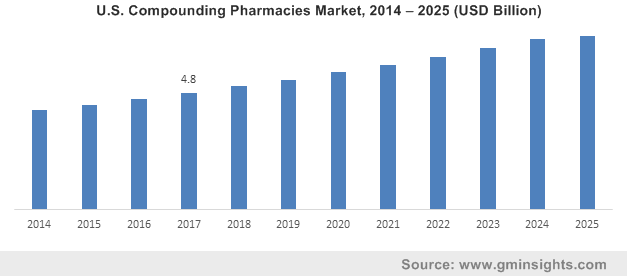U.S. Compounding Pharmacies Industry
U.S. compounding pharmacies market to be driven by a strict regulatory landscape, industry valuation to cross USD 7 billion by 2025
Endowed with numerous regulatory compliances, the U.S. compounding pharmacies market has been traversing toward becoming one of the most profitable business spaces. Owing to the lack of safety and absence of clinical clearances, compounded medications have been under stringent scrutiny that has been helping players in the U.S. compounding pharmacies to strengthen their existing manufacturing practices. The surging use of compounded medicines for pain relief and hormone replacement therapies is poised to fuel the product demand over the years ahead. The business tactics adopted by the pharmaceutical companies to proliferate the supply of superior compounded drugs will further propel the industry share.
U.S. Compounding Pharmacies Market, 2014 – 2025 (USD Billion)

In U.S, compounded medications are not approved by the FDA so far, indeed, this regulatory agency has been working continuously to encourage compounding pharmacies with the implementation of new policies. Over the last few years, FDA has been dedicatedly striving toward the development of compliances for compounding pharmacies. In fact, recently, it has deployed new guidance documents that describe the fundamental scope, insanitary conditions, and effective inspection procedures required for maintaining the effectiveness and safety after the consumption of drugs. In order to comply with the guidelines provided by the FDA, players in the U.S. compounding pharmacies industry are planning to set up drug formulation workflow processes. The integration of safe handling procedures and effective formulations will further strengthen the U.S. compounding pharmacies industry outlook over the years ahead.
Compounded drugs are important for the patients whose clinical requirement cannot be fulfilled by FDA-approved drugs. The patients suffering from the allergy need medicines without compromising on certain flavoring agents that further fuels the demand for compounded drugs which also play a critical role in case there is a shortage of FDA-approved medication. Say for instance, in the U.S., most of the FDA approved medicines have not been available in a liquid form that is primarily required for the elderly patients and children who cannot swallow pills.
Get a Sample Copy of this Report:@ https://www.gminsights.com/request-sample/detail/2961
Meanwhile, the main concern related to the compounding pharmacies is the huge number of unchecked compounds that have been largely available in the distribution centers. In accordance, the U.S. government has deployed some reforms that mandates compounding pharmacies to obtain a certification from the Pharmacy Compounding Accreditation Board (PCAB) or another equivalent regulatory body. In addition, the FDA has also sent a letter to the state pharmacy board to encourage outsourcing facilities to register with the FDA.
The registration potentially allows the so-called outsourcing facilities to sell their products in bulk to physicians and hospitals without a prescription for individual patients. Such perks provided by the regulatory bodies for encouraging compound pharmacies is poised to enhance the U.S. compounding pharmacies market size.
Currently, as per the estimates by the American Pharmacists Association, there are nearly 7,500 pharmacies providing compounding services across U.S. The number will increase over the coming years as several smaller firms have been investing in the development of low-risk drugs that will significantly boost U.S. compounding pharmacies market share.
The regulatory compliances implemented by the governing bodies will help pharmacies develop potentially more effective compounded medications on a large scale over the years ahead. The increasing use of compounded medication for overcoming the risks associated with the consumption of regulated drugs on the health of the geriatric and pediatric populace will further expedite the industry size considerably. Powered by the lower manufacturing costs of these medicines, by the end of 2024, U.S. compounding pharmacies market will generate a revenue of more than USD 7 billion.
Author Name : Sunil Hebbalkar
